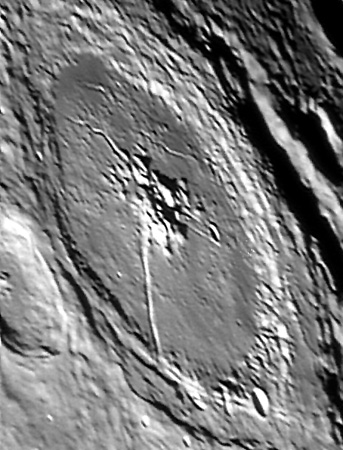Difference between revisions of "January 7, 2004"
(Created page with "__NOTOC__ =Petavius: Rilles & Volcanic Spots= ---- ===COMMENTS?=== Click on this icon image:PostIcon.jpg at the upper right to post a comment.") |
|||
| (9 intermediate revisions by the same user not shown) | |||
| Line 1: | Line 1: | ||
__NOTOC__ | __NOTOC__ | ||
=Petavius: Rilles & Volcanic Spots= | =Petavius: Rilles & Volcanic Spots= | ||
| − | + | <!-- Start of content --> | |
| − | + | <table width="85%" border="0" align="center" cellpadding="4" cellspacing="2"> | |
| − | + | <tr> | |
| − | ---- | + | </tr> |
| − | === | + | </table> |
| − | + | <table width="640" border="0" align="center" cellpadding="6" cellspacing="2"> | |
| + | <tr> | ||
| + | <td> | ||
| + | <div align="center"> | ||
| + | [[File:LPOD-2004-01-07.jpeg|LPOD-2004-01-07.jpeg]] | ||
| + | <br> | ||
| + | <span class="main_sm"><b>Image Credit:</b> | ||
| + | [mailto:kcpaulhk@yahoo.com.hk KC Pau] | ||
| + | </span> | ||
| + | </div> | ||
| + | </td> | ||
| + | </tr> | ||
| + | </table> | ||
| + | <table class="story" border="0" bgcolor="#FFFFFF" width="90%" cellpadding="10" align="center"> | ||
| + | <tr> | ||
| + | <td valign="top"> | ||
| + | <p class="story" align="center"> | ||
| + | <b>Petavius: Rilles & Volcanic Spots</b></p> | ||
| + | <p class="story">One of the most skillful lunar imagers is Hong Kong amateur KC Pau. His picture of Petavius (Sept 11, 2003, 10" newtonian | ||
| + | and Phillips Toucam) reveals details that I have never seen on any Earth-based photo, nor on the best Lunar Orbiter image! | ||
| + | The 177 km wide Petavius is an older, degraded version of nearby Langrenus. The most fascinating feature of Petavius, | ||
| + | apparently unique on the Moon, is the sharply defined rill that slices the crater floor, from the central peak to the | ||
| + | southwest wall. Other rilles radiate away from the peaks, and two rille segments - shown to be continuous on a Lunar | ||
| + | Orbiter image - cross the northeastern portion of the floor. Darkish, smooth spots are associated with the northern rilles, | ||
| + | and a smooth spot at the southern end of the floor is now revealed for the first time to be associated with a shallow, | ||
| + | pitted dome. Are the smooth patches volcanic pyroclastic (ash) deposits or mare lava flows? High Sun views show that the | ||
| + | patches are as dark as mare lavas, but multi-spectral Clementine images show neither the blue of fresh mare material, nor | ||
| + | the red of pyroclastics.</p> | ||
| + | <p><b>Related Links:</b> | ||
| + | <br> | ||
| + | More [http://observingthesky.org/index.php?p=174 KC Pau]</p> | ||
| + | <p><b>Yesterday's LPOD:</b> [[January 6, 2004|Gores of the Moon]] </p> | ||
| + | <p><b>Tomorrow's LPOD:</b> [[January 8, 2004|The Right Stuff in Lunar Science]] </p> | ||
| + | </td> | ||
| + | </tr> | ||
| + | </table> | ||
| + | <hr> | ||
| + | <p align="center" class="main_titles"><b>Author & Editor:</b><br> | ||
| + | [mailto:tychocrater@yahoo.com Charles A. Wood]</p> | ||
| + | <!-- Cleanup of credits --> | ||
| + | <!-- Cleanup of credits --> | ||
| + | <!-- Cleanup of credits --> | ||
| + | <!-- Cleanup of credits --> | ||
| + | <!-- Cleanup of credits --> | ||
| + | <!-- Cleanup of credits --> | ||
| + | <!-- Cleanup of credits --> | ||
| + | <p> </p> | ||
| + | <!-- End of content --> | ||
| + | {{wiki/ArticleFooter}} | ||
Latest revision as of 11:12, 6 June 2015
Petavius: Rilles & Volcanic Spots
|
|
|
Petavius: Rilles & Volcanic Spots One of the most skillful lunar imagers is Hong Kong amateur KC Pau. His picture of Petavius (Sept 11, 2003, 10" newtonian and Phillips Toucam) reveals details that I have never seen on any Earth-based photo, nor on the best Lunar Orbiter image! The 177 km wide Petavius is an older, degraded version of nearby Langrenus. The most fascinating feature of Petavius, apparently unique on the Moon, is the sharply defined rill that slices the crater floor, from the central peak to the southwest wall. Other rilles radiate away from the peaks, and two rille segments - shown to be continuous on a Lunar Orbiter image - cross the northeastern portion of the floor. Darkish, smooth spots are associated with the northern rilles, and a smooth spot at the southern end of the floor is now revealed for the first time to be associated with a shallow, pitted dome. Are the smooth patches volcanic pyroclastic (ash) deposits or mare lava flows? High Sun views show that the patches are as dark as mare lavas, but multi-spectral Clementine images show neither the blue of fresh mare material, nor the red of pyroclastics. Related Links:
Yesterday's LPOD: Gores of the Moon Tomorrow's LPOD: The Right Stuff in Lunar Science |
Author & Editor:
Charles A. Wood
COMMENTS?
Register, Log in, and join in the comments.




